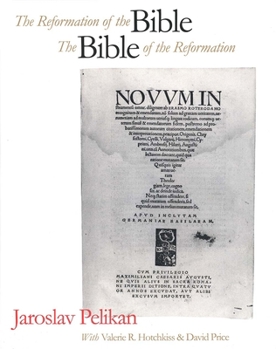The Reformation of the Bible/The Bible of the Reformation
Select Format
Select Condition 
Book Overview
It is equally true that the Reformation was inspired and defined by the Bible and that the Bible was reshaped by the intellectual, political, and cultural forces of the Reformation. In this book, a distinguished scholar--whose contributions to the field of religious studies have won him wide renown--explores this relationship, examining both the role of the Bible in the Reformation and the effect of the Reformation on the text of the Bible, Biblical studies, preaching and exegesis, and European culture in general. Jaroslav Pelikan begins by discussing the philological foundations of the "reformation" of the Biblical text, focusing on the revival of Greek and Hebrew language study and the important contributions to textual criticism by humanist scholars. He then examines the changing patterns of interpretation and communication of the Biblical text, the proliferation of vernacular versions of scripture and their impact on various national cultures, and the impact of the Reformation Bible on art, music, and literature of the period. The book is richly illustrated with examples of early printed editions of Bibles, commentaries, sermons, vernacular translations, and other works with Biblical themes, all of which are identified and discussed. The book serves as the catalog for a major exhibition of early Bibles and Reformation texts that has been organized at Bridwell Library, Perkins School of Theology, Southern Methodist University, and will also be shown at the Yale Center for British Art, the Houghton Library and the Widener Library at Harvard University, and the Rare Book and Manuscript Library at Columbia University.
Copublished with the Bridwell Library, Southern Methodist University
Copublished with the Bridwell Library, Southern Methodist University
Format:Hardcover
Language:English
ISBN:0300066678
ISBN13:9780300066678
Release Date:March 1996
Publisher:Yale University Press
Length:214 Pages
Weight:2.15 lbs.
Dimensions:0.8" x 8.3" x 10.3"
Customer Reviews
1 rating
Pelikan at his best
Published by Thriftbooks.com User , 21 years ago
This text is two distinct books in one volume. The second part of the book is an impressive exhibition catalogue of Bibles and surprisingly diverse Reformation texts, filled with lovely illustrations, bibliographical information, and a superb historical narrative. Two scholars, Valerie R. Hotchkiss and David Price, are responsible for the insightful and learned descriptions affixed to each of the exhibition contributions. In a volume of this work, the illustrations often overshadow the appended descriptions; this is decidedly not the case here, for Hotchkiss and Price have provided a feast for both the eyes and the mind. The first half of the volume is comprised of four essays concerning the world of the Renaissance and the Reformation that resulted in the publication of myriad translations and editions of the Bible. Jaroslav Pelikan draws on his earlier writings on the Bible, but the result is a fresh and stimulating prose that will serve to instruct and challenge readers. In his first essay, "Sacred Philology," Pelikan charts the Renaissance scholars' recovery of the ancient languages, which culminated in a flood of biblical translations and editions and underpinned the ongoing canonical debates between Catholics and Protestants. The second essay, "Exegesis and Hermeneutics," builds upon the first contribution, arguing that reformers such as Luther came to reject the binding authority of tradition in their exegesis and broke from the fourfold sense of medieval hermeneutics (the literal, moral, allegorical, and anagogical). Instead, Scripture came to be interpreted-now in the grammatical, literal, and historical senses-in light of the "analogy of faith." Using these tools of sacred philology and exegesis, those who translated Scripture had to determine the correct meaning of the biblical text and translate often complex doctrinal notions into the vernacular. In "Bibles for the People," Pelikan provides a series of fascinating examples of just how difficult this could be, with sections devoted to the German, English, Arabic, Czech, Danish, Dutch, and even the Natick-Algonquin Bibles. Bible translators were faced with numerous challenges (vocabulary, grammar, and syntax, for example) as they sought to translate the Bible, with its Protestant meaning, into new languages. The final essay, "The Bible and the Arts," addresses the "cultural fallout" of the Reformation-that is, the impact that the publication of Reformation Bibles had on art, music, and literature during the Reformation. Some of Europe's finest artists, such as Lucas Cranach and Albrecht Durer, made significant contributions to the genre of the illustrated Bible and assisted the reformers in their determined assault on Rome by providing graphic expressions of Reformation polemics. Literature and music too would come to reflect in countless ways the impact of the Reformation Bible. While the use of Greek, Hebrew, Latin, and German may hinder some readers, all can benefit from the author'






